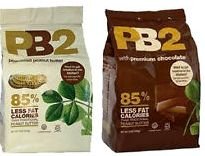
P2B peanut butter on Amazon
Our kids are growing up AND out, but you don’t need me to tell you this. Despite the awareness, nothing seems to be changing, despite some easy answers like this one.
I have always been a strong advocate of nuts (the raw ones with no added oils to ruin the health benefits) and the research strongly supports eating them. All types. But what about peanut butter? Technically, it’s a legume and doesn’t fall into the same category as nuts.
However, the plant-based protein content, the fiber and the type of fats in peanuts also work in their favor as they do nuts. For me, one of my favorite breakfasts is high fiber whole grain bread with real peanut butter (more on this in a minute) with bananas sliced on top.
I recommend peanut butter frequently to patients, but always caution them on “real” versus “fake” peanut butter. Peanut oil is a liquid at room temperature and also oxidizes relatively quickly when exposed to oxygen so it is not stable in the cabinet once opened.
To get around this, manufacturers hydrogenate peanut oil, changing the characteristics of the oil into something that leads to obesity, diabetes and cancer. For this reason, I steer patients away from brands like Jif and Skippy because they are absolutely not good for your health.
I have always advocated the brands that require mixing of the oil and refrigeration. I remain leery of other brands that use palm oil to keep the jar emulsified. Brands like Naturally More and MaraNantha are good brands to stick with. Tip: leave the peanut butter upside down in the cabinet until it is ready to be opened, then flip it over, mixing the oil all the way to the bottom and refrigerating the jar; this should keep the consistency even throughout its use.
Only recently did I discover powered peanut butter. I bought it with no actual delusions of finding it enjoyable, but was pleasantly surprised to find it quite enjoyable. I now buy P2B peanut butter off of Amazon (which can be found by clicking here). The advantage? Regular peanut butter has around 180 calories per 2 tablespoons. The powered variety? A mere 45 per same serving size.
Back to this particular study. Researchers looked at a group of 262 sixth grade Mexican-American students and evaluated the relationships between body weight, blood lipids and peanut butter intake. Here’s what they found:
- Children who were peanut eaters were less likely to be overweight or obese.
- Peanut consumers had higher intakes of several vitamins and micronutrients (i.e., magnesium, vitamin E).
- Peanut consuming children also had lower LDL and total cholesterol levels.
This is all pretty good news, especially given how acceptable peanut and peanut butter eating is to children. Of course, the protective effect may not be just from the peanuts and peanut butter, but from the fact that peanut butter is typically a breakfast food. That would mean that these 6th grade children are more likely to be eating breakfast, which has been shown to be beneficial for ideal body weight in children.
Further, this study did not look at the intakes of “real” versus “fake” peanut butter. It is highly likely that, given the opposite health ends of the spectrum between the two, real peanut butter would be far more protective than what researchers saw in this study. Not a bad thing at all.
